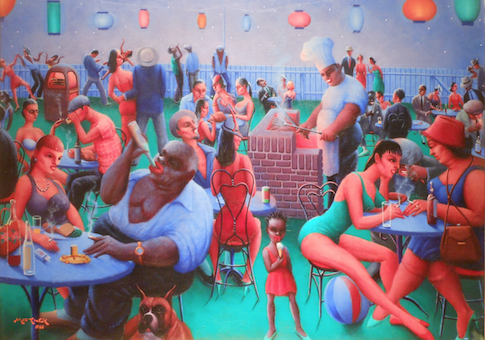An exhibit now at the Whitney Museum describes the classically trained African-American painter Archibald J. Motley as a "jazz-age modernist." It’s an apt description for this painter of chromatically charged, practically rhythmic scenes of black nightlife. Motley was drawn to the carnival atmosphere of Chicago’s "Black Belt," a district whose sidewalks were filled street preachers, pimps, couples out for a stroll, and lone men on the make.
While he is best remembered for painting these Saturday scenes, Motley also turned his attention to Sunday. Though it is possible to miss this fact by reading only its more canonical chroniclers, the Jazz Age was also a time of revival. In paintings like Getting Religion, a street preacher is flanked by instrumentalists and painted like a minstrel. Today we tend only to see an ugly racial stereotype, but Motley is also trying to show how the spirit of Azusa breathed life into Delta bones. In Tongues (Holy Rollers), the preacher may appear to be dressed like a nightclub entertainer, but that just reflects how for Motley church singing and club swinging make the same wild bid for transcendence.
Motley had a forgiving but distant eye. He took the side of sinners and loathed the language of "racial uplift." Still, there were moments of reserve. In Cocktails, he shows a group of well-dressed ladies laughing and talking without any apparent concern for another woman who has passed out, or for the darker-skinned man waiting on them. Sitting in silent censure of these ladies is a painting of a Dominican friar with two other monks. The contrast between the attentive severity of these figures and the indifferent gaiety of the ladies does not exactly flatter the revelers.
It is little surprise that this moralizing moment draws on monastic imagery. Motley was a Catholic who depicted his own church with a seriousness equal and opposite to the breeziness with which he painted Pentecostal faith. A crucifix prominently hangs in Mending Socks, a reverent portrait of his grandmother, and in Self-Portrait (Myself at Work). Motley’s Christian faith gave him the visual language for his final and most political painting, the dreadful gothic allegory The First Hundred Years.
For all the life he brought to jazz subjects, Motley’s eye sees more in quiet scenes. In Brown Girl After the Bath, he reworks The Toilet of Venus to create a new light-skinned goddess of love. She is a deity so unembarrassed in her beauty, so serenely innocent, that her shoe has come loose, like that of the infant Christ in the icon of Our Lady of Perpetual Help. It is an image Motley certainly would have known, and his simultaneous allusion to it and to Velazquez is him at his most clever and masterly. The music we hear at this moment isn’t that of jazz syncopation but of orderly classicism.
